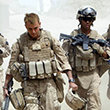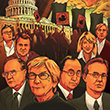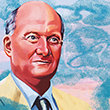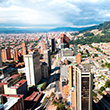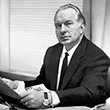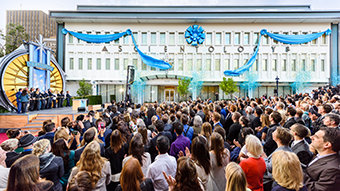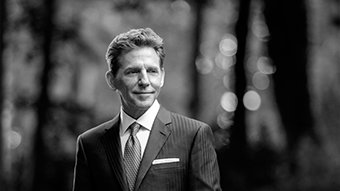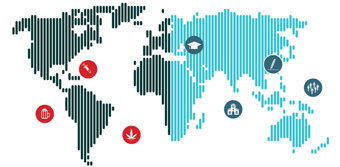
When David Miscavige, Chairman of the Board Religious Technology Center, traveled to Bogotá, Colombia, to preside at the opening ceremony of the first Scientology Ideal Organization in South America, he knew it was a city with a ‘past.’ But he also knew a thing or two about its present, and its future.
Cradled beneath chilly Andean peaks, but soaring at 8,500 feet above sea level, Bogotá isn’t what you might think. It’s a thriving metropolis of nearly 8 million people. Tourism is booming, crime rates are down. Bogotá is Colombia’s beating heart, an engaging and vibrant capital steeped in sophisticated urban cool. It’s a city with both an artistic center and a creative edge—and it has an admirably strong sense of itself. “They consider themselves the city closest to Heaven on Earth,” says Mr. Miscavige.
The lofty city, and all of Colombia, passionately welcomed Scientology and its newest Ideal Org at the opening event July 5. The ultramodern structure rises eight stories above the city’s bustling northern district of Usaquén. The occasion drew 2,500 Scientologists and their guests, and high-level officials from Colombia’s military, law enforcement and government.

Dr. Sandra Rincón, advisor to the Ministry of Social Integration in Bogotá City, praised the org as “a beacon of peace and sanity” for not only the country’s capital, but for all of Colombia—a country that has seen its share of troubles.
Since the 1948 assassination of Jorge Eliécer Gaitan—a politician whose threats to break the stranglehold of Colombia’s oligarchy would lead to his demise—the country has been a four-sided civil war battleground. Hundreds of thousands were killed over the ensuing five years. Millions were abused and displaced over the next three decades. Crime and police and military corruption were rampant.

Then beginning in the late 1970s, Colombia became the world’s leading producer and trafficker of cocaine. Merciless drug gangs transformed the country into one of the most dangerous regions on the planet in the 1980s and into the 1990s. In cities like Medellin, the leading cause of death wasn’t heart disease or cancer but homicide. Literally thousands of tons of cocaine were smuggled by the cartels into the United States and Europe.
Bernardo Solis, a theater professor and Fulbright Scholar who was born in Colombia in the late 1950s and returned for several lengthy stays in his adult life, recalls that urban guerrilla warfare and mass chaos were a daily reality. “You’d be walking around hearing bombs go off pretty much all the time,” Solis says. “This was maybe 1980 as [notorious drug lord] Pablo Escobar is rising up. Even in my own family, I had cousins who endured home invasion robberies and others who were kidnapped and held for ransom.
“The most popular method of execution found these drug assassins tooling around on motorcycles to do their hits. One guy would drive. The passenger would shoot the victim in the head, or wherever would prove lethal—and they’d speed off. This would happen all over Colombia multiple times a day.”
Even as demand for cocaine waned in the mid-1990s, Colombia remained a nightmarish society rife with human rights atrocities—most of them perpetrated by the very group tasked with protecting the people: The military.

A scandal exploded in 2008 that revealed rogue Colombian Army soldiers, motivated by bounty payments, had carried out nearly 1,000 extrajudicial executions during the previous decade. The victims—typically down-on-their-luck men lured into service with the promise of a job—were dressed in military fatigues and falsely presented as guerrillas killed in combat. The purpose was to boost the body count of supposed kills in Colombia’s protracted conflict with the opposition Revolutionary Armed Forces of Colombia (FARC).
Some 800 Army members and officers were ultimately prosecuted and convicted. It proved to be something of a tipping point for a nation forced to peer deep into its moral soul.
As Lt. Col. Anstrongh Polania, Chief of the Department of Joint Operational Law for the Colombian Ministry of Defense, noted during his remarks at the Bogotá Ideal Org opening, “In the course of this bloody conflict [in Colombia] that has lasted almost 60 years, the Army set aside the protection of human rights and respect for international law. I speak for many when I say I am proud of my nation. I am also proud of my uniform. But I also recognize there must be a balance between the human being and the soldier.”
By the time Profressor Solis paid his last visit to Bogotá on a six-month Fulbright stay in 2010, he could see Colombia was changing. The urban warfare had largely disappeared and a burgeoning middle class had arisen. “We still got the speech from the U.S. State Department about security issues,” he remembers, “but it just felt much safer. They told us to continue to be wary. But it was just a way different vibe.”
The numbers bear it out. Neighboring Peru is now a bigger drug producer than Colombia. Colombia’s National Police report that 2014 was the country’s least violent year in three decades, or since the cartels took control—with a homicide rate at its lowest since the late 1970s. There is also the perception that the Army and police force have done much to clean up their act.
Of course, the big question is why Colombia has done such an about-face. The general consensus is that it can be traced to a combination of factors, including the nation’s taking on of the cartels (with an assist from the United States’ $9 billion Plan Colombia initiative implemented by the Clinton Administration in 2000), some courageous politicians, and perhaps a populace that grew tired of living in a war zone.

There is another influence in the ongoing Colombian transformation: The presence and programs of the Church of Scientology, which several of the high-ranking members of the nation’s military affirmed during the July 5 ribbon-cutting of the Bogotá Ideal Org.
The story of the religion in Bogotá dates to the 1970s, when Scientologists first began Dianetics and Scientology dissemination there. The Church’s presence grew throughout Colombia over the decades until 2009, when its motor vessel Freewinds sailed to the port city of Cartagena for its 20th anniversary refit.
The ship’s presence would facilitate a close relationship between the Church and the Colombian military and police forces, whose members began taking Scientology courses onboard the vessel with the encouragement of General Carlos Ramiro Mena and Colonel Ricardo Antonio Prado.
At the same time, Scientology-sponsored humanitarian programs ramped up in Colombia. Sandra Poveda—a Colombian, a Scientologist and a dentist—founded Youth for Human Rights Colombia in May 2009. It has since worked to educate the national Army in international human rights law, helping to forge massive change in the military mindset.
Lt. Col. Polania boasted that incidence of human rights violations in the Army are now at an all-time low—with human rights complaints against the Colombian military plummeting more than 96 percent after the campaign reached 100 percent of Colombian army personnel in just 12 months. “And it is not only the Army we reached,” Polania adds. “We trained judges, prosecutors, magistrates, attorneys and even schoolchildren across all of Colombia. And everyone we taught learned that the protectors of human rights form the backbone of our nation.”
So popular has Polania’s campaign been that he was recently invited to Mexico to oversee a five-day boot camp seminar attended by all of the nation’s generals along with the rank-and-file military.
The work of Colombian telenovela star Maria Lara and stand-up comedian Andrés López was instrumental in bringing the Church-sponsored The Way to Happiness campaign to the nation, holding seminars and distributing booklets that espouse the 21 precepts of the common sense moral code developed by L. Ron Hubbard.
Lt. Col. Edgar Rojas, Special Ops Commander for Rural Zones for the Colombian National Police, addressed the impact of The Way to Happiness in his country and on the police force after having arrived at the Bogotá Org grand opening event late, fresh from a military operation deep in the jungle. He assured the crowd, “Even when I’m in the jungle, The Way to Happiness keeps me grounded.”
He continued, “I have observed real changes in my men and fellow police officers once they study The Way to Happiness. Believe me, it is the checklist for life.”

The Church-sponsored antidrug program The Truth About Drugs has also found a welcome reception in Colombia. This past March, a partnership was signed between the Anti-Narcotics Office of the National Police, the Ministry of Education and Drug-Free Colombia to incorporate Truth About Drugs materials with the current Anti-Narcotics Unit’s program.
In his remarks at the opening, Lt. Col. Carlos Peña—coordinator for Anti-Drug Education with the Colombian Anti-Narcotics Department—praised the program for “opening the eyes of people to the dangers of drugs. And with each one, another life is saved. This program truly prevents drug consumption.”
Of course, the drug stigma is one that continues to haunt Colombia, as its status as a world narcotics capital was so entrenched. Lt. Col. Peña admitted, “Drugs are [still] the biggest enemy of our nation. And in this battle, those who lack knowledge and understanding are at continual risk.” But he believes that programs like The Truth About Drugs have helped to “change the perception of associating Colombia with drugs, terrorism and corruption.”
Captain John Alexander Galindo Vega, Operations Director of the Circle of Aid Technicians of Colombia (CINAT), spoke of his organization’s work with the Scientology Volunteer Ministers in coordinating disaster response and assistance.
“When I first saw the Volunteer Ministers,” Capt. Vega said during his Bogotá Org remarks, “what struck me was their deep humanitarian spirit and devotion to a grand goal—to bring real help. Together, we have done collaborative projects in Medellin and Barranquilla, rescuing thousands from floods. We worked as the official emergency response team at the Brazil World Cup in 2014. And this year, we took on Nepal [to rescue and assist earthquake victims].”
Capt. Vega likewise noted that in establishing the International Academy of Disaster Management, CINAT featured the technology of the Volunteer Ministers in its curriculum. He later added that he believes the VMs “have helped to change perceptions of what may be possible in Colombia and around the world.”
The Scientology Ideal Org in Bogotá is the latest in a worldwide network of churches providing an optimal environment for the religion’s services and study, and a central gathering place where all people are welcome and everyone works together in the pursuit of social betterment. The Bogotá Ideal Org further provides visitors with an introduction to Dianetics and Scientology, and to the many Scientology-sponsored humanitarian initiatives active in Colombia and around the world.
During its dedication, Mr. Miscavige told the large crowd, “Should any of you wonder how this day came to pass, well look no further than your own innate passion for humanity.”
While every Ideal Org opening carries a sense of spectacle, the Bogotá event was particularly inspirational. Perhaps it was the timing—the final jewel placed in a crown of reforms that have so altered the Colombian landscape.
Lt. Col. Rojas of the Colombian National Police said he has seen that the population of Colombia benefits from the Scientology presence in the country, and that the religion has helped people “change the patterns of their thinking and their way of seeing the world.”
There’s also something the Lt. Col. sincerely hopes—to see more Scientology Churches in his country and across the South American continent.





